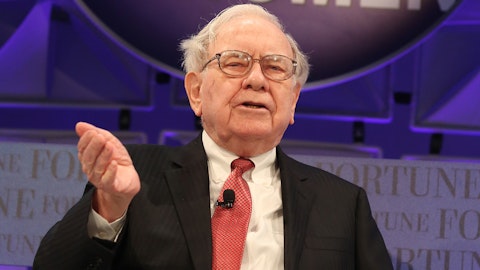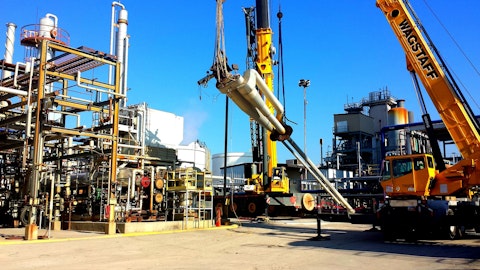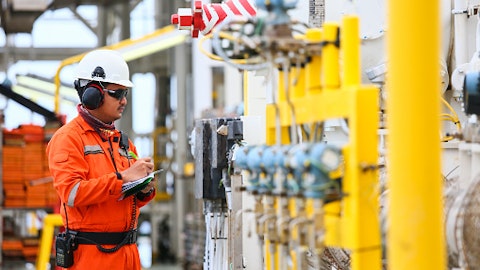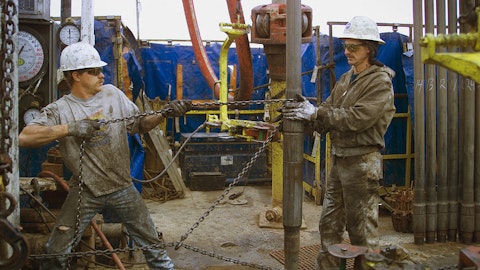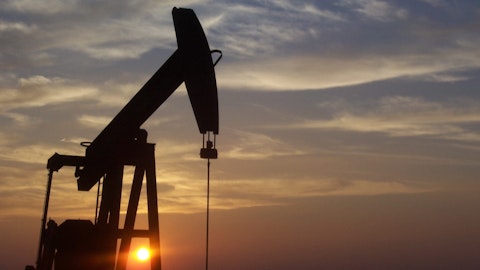Nabors Industries Ltd. (NYSE:NBR) Q4 2022 Earnings Call Transcript February 8, 2023
Operator: Good afternoon, and welcome to the Nabors Industries’ Fourth Quarter 2022 Earnings Conference Call. All participants will be in a listen-only mode. After today’s presentation, there will be an opportunity to ask questions. Please note that this event is being recorded today. I would now like to turn the conference over to the William Conroy, Vice President of Corporate Development and Investor Relations. Please go ahead, sir.
William Conroy: Good afternoon everyone. Thank you for joining Nabors’ fourth quarter 2022 earnings conference call. Today, we will follow our customary format with Tony Petrello, our Chairman, President, and Chief Executive Officer; and William Restrepo, our Chief Financial Officer, providing their perspectives on the quarter’s results along with insights into our markets and how we expect Nabors to perform in these markets. In support of these remarks, a slide deck is available both as a download within the webcast and in the Investor Relations section of nabors.com. Instructions for the replay of this call are posted on the website as well. With us today, in addition to Tony, William and me, are other members of the senior management team.
Since much of our commentary today will include forward expectations, they may constitute forward-looking statements within the meaning of the Securities Act of 1933 and the Securities Exchange Act of 1934. Such forward-looking statements are subject to certain risks and uncertainties as disclosed by Nabors from time to time in our filings with the Securities and Exchange Commission. As a result of these factors, our actual results may vary materially from those indicated or implied by such forward-looking statements. Also, during the call, we may discuss certain non-GAAP financial measures. Such as net debt, adjusted operating income, adjusted EBITDA, and adjusted free cash flow. All references to EBITDA made by either Tony or William during their presentations, whether qualified by the word adjusted or otherwise, mean adjusted EBITDA as that term is defined on our website and in our earnings release.
Likewise, unless the context clearly indicates otherwise, references to cash flow mean adjusted free cash flow as that non-GAAP measure is defined in our earnings release. We have posted to the Investor Relations section of our website a reconciliation of these non-GAAP financial measures to the most recently comparable GAAP measures. With that, I will turn the call over to Tony to begin.
Tony Petrello: Good afternoon. Thank you for joining us as we present our results. We made several notable accomplishments during 2022, and the year culminated on a high note with an impressive fourth quarter performance. Each of the operating segments in our portfolio again performed well. Adjusted EBITDA in the fourth quarter totaled $230 million. This marks the third consecutive quarter of sequential EBITDA growth above 20%. Consolidated revenue increased 10% sequentially. Our global average rig count for the fourth quarter increased by 3.4 rigs. This growth was driven by increases in both US and International markets. Drilling Solutions EBITDA accelerated and exceeded $30 million. Combined, our Advanced Drilling Solutions and Rig Technologies segments accounted for over 16% of total EBITDA.
This contribution is more than double their share back in 2020. In the fourth quarter, we again reduced net debt. Our net debt stands below $2.1 billion. I am pleased to report we again made progress on our five keys to excellence. These critical objectives comprising the investment thesis for Nabors include maintaining our leading performance in technology in the US market, expanding and enhancing our international business, advancing technology and innovation with demonstrated results, improving our capital structure, and finally, our commitment to sustainability and the energy transition. Let me update each of these, starting with our performance in the US. We averaged 95 rigs in the fourth quarter, up three from the third. The early margins in the Lower 48 stepped up very materially in the quarter.
Our average daily margin grew by more than 30% to $14,600. When including the contribution from NDS, our margin is even higher. I’ll discuss this in a few moments. As both the industry and Nabors rig counts rebounded in recent years, we purposely kept our contract duration short. This strategy has enabled us to realize pricing and margins that increasingly reflect the outstanding value we consistently deliver. We have added term to our Lower 48 backlog when we believe it is value enhancing. The Lower 48 market remains concentrated on the most capable rigs and premier field performance. Nabors’ differentiated approach to this market includes best-in-class rig technology and the industry’s broadest portfolio of advanced complementary solutions.
Our vision of the rig as a platform for drilling and the delivery of related services has gained significant market traction. The value we generate from our technologies leads the industry. We will cover this in more detail in a few minutes. Now, I’ll discuss our international business. Daily margins in this segment increased in the fourth quarter, reaching $14,900. Profitability improved in most of our markets. In Saudi Arabia, the better results reflect improved pricing on the recent contract renewals. Also in Saudi Arabia, SANAD deployed the second In-Kingdom newbuild rig in late December. At the same time, SANAD reactivated an additional existing rate. SANAD expects to deploy three additional newbuilds during the remainder of the year. Each newbuild will be contracted for a six-year initial term, followed by a full year renewal.
Further, the newbuilds generated a whole cash-on-cash return on the newbuild CapEx, maintenance CapEx, and allocated G&A within the initial contract term. We expect additional awards at a cadence of five per year. Now, let’s discuss our technology and innovation. Our focus areas include automation, digitalization, and robotization. Here at Nabors, we continually strive to push the envelope in terms of innovation and advanced technology. During the fourth quarter, we set a major industry milestone by deploying a first of its kind robotics module on an existing rig. RZR, as the module is known, will be a game changer on two important fronts. First, performance, robotization brings a step change improvement and consistent precision and control.
Next, safety, RZR removes people from the most hazardous area of the rig, the red zone; and one last important point to make, RZR is modular, so it can be retrofitted onto existing drilling rigs whether Nabors’ or a third-party. In the fourth quarter, Drilling Solutions EBITDA increased sequentially by 18%. Gross margin increased in the fourth quarter to a record 52.8%. This high margin, high free cash flow business, grew by more than 50%year-on-year. This is the type of growth we expect from a technology-centric business. We expect similar growth in 2023. Let me illustrate the value NDS generates. The combined average daily margin in the Lower 48 from our Drilling and Drilling Solutions to businesses was 7,372 in the fourth quarter. Of that, NDS contributed nearly $2,800 per day.
That combined figure increased by 28% versus the third quarter. The typical Nabors rig in the Lower 48 runs about 6.5 NDS services. This penetration increased again in the fourth quarter. We have seen a consistent quarterly increase in the services count reflecting strong market adoption of the portfolio. Among automation and digital services, we saw a near doubling of SmartPLAN installations, and broad growth across the performance tools portfolio, including ROCKit, REVit and SmartDRILL. In the fourth quarter, NDS revenue on US third-party rigs grew by 10% versus the previous quarter. This market segment is a key focus area for NDS and we continue to increase penetration there. Next, let me update our progress to improve our capital structure.
In 2022, we reduced net debt by $186 million. This improvement was driven primarily by excellent free cashflow resulting from the strong profitability of our operations, excellent working capital performance, and disciplined capital spending. We expect even greater improvement in 2023. I’ll finish this part of the discussion with remarks on sustainability and the energy transition. As I have said previously, our three focus areas include reducing our own environmental footprint, capitalizing on adjacent opportunities, and investing strategically in leading edge companies with clear adjacencies to our core activity. Today, I will highlight several specific technology initiatives, which are currently underway. First is our PowerTAP module. This connects rigs to the grid.
We have recently deployed 14 of these units, including multiple units on third-party rigs. Second, our SmartPOWER Advisory and Control system optimizes utilization of the engines and reduces emissions. This solution is currently installed on more than 75 rigs. Third, the nanO2 diesel fuel additive improves engine performance and reduces emissions. We have already successfully treated more than 10 million gallons of diesel to-date. I’m very enthusiastic about PowerFLOW, our energy storage system. This technology enables us to incorporate innovative storage solutions into our engine management systems. This technology uses super capacitors in place of lithium batteries. Our first unit is currently deployed on one of our rigs in the Bakken. We have expectations for very strong growth from these initiatives in 2023.
Margins in this portfolio should be highly accretive to the company average over time. Now, I will spend a few moments on the macro environment. With the spot and future prices for WTI in the current range, we believe the outlook for continued increases in-drilling activity in Lower 48 is still constructive. We expect these increases to materialize as we move throughout the year. Several factors in the current macro environment could impact our outlook. Foremost among these is the possibility of a recession, which reduces the demand for oil. In the US, labor availability has begun to improve, in part from the easing of the pace of rig additions. As for the broader supply chain, inflation has declined in key areas, namely metals and metal subassemblies.
That said, lead times for certain components remain extended. Our vertical integration and global supply chain continue to enable us to satisfy demands of customers. Notwithstanding these factors, energy commodity markets remain constructive, giving us confidence in our outlook through 2023. Next, I will spend a few moments on day rates. Our Lower 48 results demonstrate the unprecedented robust pricing environment. Average daily revenue in Lower 48 increased by more than $3,500 sequentially or 12% up to $32,700. We have recently signed contracts with revenue per day above $40,000, and that’s before adding NDS content. We have a material portion of the fleet remaining repriced to the current market. Therefore, we expect daily revenue and margins to continue to climb.
We and the Lower 48 industry have inventories of high-spec rigs, which can be reactivated. Importantly, the cost to reactivate these rigs is significant. For idle rigs, we received total reactivation spending of more than $2 million for the next seven or so units. For the following eight, that price tag moves up to about $6 million. We believe the Lower 48 drillers have a limited appetite to incur this level of expense speculatively. This puts a lid on the ready supply of additional rigs. In the international market, we see steady increases in activity across many of our major geographies. This increase in demand supports generally higher day rates and margin expansion. Once again, we surveyed the largest Lower 48 clients at the end of the fourth quarter.
This group accounted for approximately 34% of working rig count. Our survey adjusted for one outlier in a special situation indicates essentially net flat activity for the group through the end of the first quarter. We believe this trend primarily reflects some weakness in natural gas prices. Despite the resulting market churn, we have been able to shift return rigs from gas to oil drilling. Further, inquiries for additional rigs in the Permian Basin have been increasing. These positive signals along with refreshed budgets and better availability of casing suggests potential growth in 2023. Operators in several of our existing international markets are indicating increases in their activity. We see potential opportunities to add rigs in multiple markets, both in the Middle East and Latin America.
And we continue adding newbuilds in Saudi Arabia. SANAD has recently received awards for five more newbuilds, bringing the total so far to 10. These rigs are impactful. Of the initial five which were previously awarded, we expect to deploy the three remaining rigs at one per quarter beginning this quarter. The second five should roll out beginning as early as the end of 2023. We estimate each newbuild will generate annual EBITDA of approximately $10 million. With the first 10 awards in hand, SANAD is on the way to realizing EBITDA of more than $100 million per year from the newbuild program. Let me wrap-up my remarks with the following. We expect activity across our markets to increase this year. With our advanced portfolio of rigs, services and equipment, Nabors is ideally positioned to capitalize on this environment.
In summary, Nabors remains poised to deliver improving financial results, increasing free cash flow, and greater returns to our investors. Now, let me turn the call over to William, who will discuss our financial results and guidance.
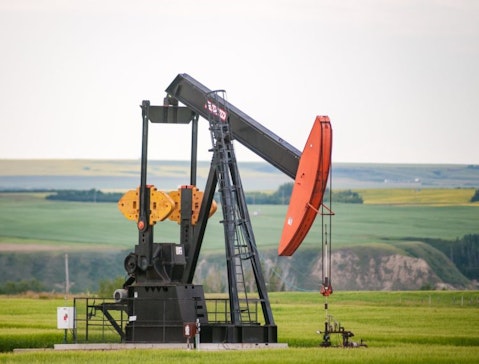
Photo by David Thielen on Unsplash
William Restrepo: Thank you, Tony. Fourth quarter results were significantly better than we anticipated. Both US and International segments experienced sustained pricing momentum and steady increases in rig count. NDS continued on its growth path with improving results across its business lines and Rig Tech had its best quarter in a long time with signs of strength across its portfolio of offerings. Although the first quarter is a bit shorter than the fourth, we continue to ride favorable trends and expect to deliver meaningful sequential EBITDA growth this quarter. Average pricing for our US fleet continues to expand. International rig count and pricing also continues to improve, and we expect NDS to provide further momentum to our total results in the first quarter.
For the full year, 2022 revenue from operations was $2.7 billion. This compares to $2 billion for 2021, a 32%improvement year-over-year. All of our segments grew significantly during 2022, but Lower 48 drilling and NDS globally led the way with revenue increases of 78% and 41%, respectively. International Drilling 2022 revenue increased by 15%. We experienced an acceleration towards the end of last year and expect 2023 to deliver a similar year-on-year growth as our international markets appear to be picking up steam. For the fourth quarter of 2022, revenue from operations was $760 million compared to$684 million in the third quarter, a 10% improvement. US Drilling revenue increased by 12% to $333 million. Lower 48 revenue grew by almost 16%, reflecting higher rig count and an increase in daily revenue of over $3,500 or 12%.
Average daily revenue reached $32,700 up from $29,200 in the third quarter, and we expect it to continue to increase over the coming quarters. Over the past year, day rate increases have accelerated as compared to the increases of the prior year. In the fourth quarter of 2021, leading edge revenue per day was in the low $20,000 range and we are now seeing contracts with revenue per day in the low $40,000s. We expect average pricing for our fleet to maintain its upward trajectory. And although leading-edge pricing has remained stable over the last few months, depending on the evolution of rig count over the next couple of quarters, leading-edge pricing could continue to expand. Despite the potential for further day rate increases, we believe we should return to our traditional long-term contract coverage in the Lower 48 of around 20% to 30%.
Over the last few months, we have been more focused on adding more term onto our portfolio of contracts. Revenue from our International segment also increased to $380 million or about 4%for the quarter. The improvement was driven primarily by higher activity and improved day rates in Saudi Arabia and Colombia, as well as by our impactful Papua New Guinea rig going on full operating rate in November. Revenue from Drilling Solutions and Rig Technologies also grew sequentially by 15% and 24%, respectively, for this quarter, outpacing the brisk growth in growing rate revenue. Total adjusted EBITDA for the quarter was $230 million compared to $191 million in the third quarter, an increase of $39 million or 21%. EBITDA margins improved by almost 280 basis points to over 30%.
That equates to incremental margins of over 59%. A $30 million increase in US Drilling EBITDA was driven by an improvement in Lower 48 drilling margins. Lower 48 drilling EBITDA rose by almost $33 million, a 37% improvement compared to the prior quarter, primarily related to sustained pricing increases. Average rig count in the Lower 48 increased to 95 rigs, up approximately three rigs from the third quarter. And daily margin came in at $14,600, up by almost $3,500 per day, a 31% increase. Daily operating expenses held steady around the $18,000 mark. At the end of the fourth quarter, Nabors’ utilization of high-spec rigs was at 86%. South Texas and East Texas each had only one high-spec rig available. And in the Northeast, all nine of Nabors’ high-spec rigs were working.
We did see some weakness in gas markets with multiple rigs returned by smaller players. However, we were able to place these rigs expeditiously with other customers for predominantly oil-focused activity. Our rig count has held steady during the month of January. But given the continued uncertainty in the price of natural gas, we expect further churn during the remainder of the quarter. This has had an impact on our expectations for rig count growth in the first quarter. Consequently, we are currently projecting a rig count to increase by one rig versus the average of the fourth quarter. On the other hand, the pricing trends have continued to develop even stronger than we initially expected. We currently anticipate our daily gross margin to land between $16,100 and $16,300 in the first quarter.
This is without the additional contribution from our solutions business. International met our expectations in terms of both rig count and margins. Our International segment delivered EBITDA of almost $89 million, an improvement of $2.9 million or 3.4% over third quarter results. International rig count improved with the deployment of the second newbuild rig and the reactivation of a legacy rig in Saudi Arabia, both late in the quarter as well as one more rig in Colombia. Gross margin increased by over $300 to $14,900 per day due to higher day rates related to contract extensions in Saudi Arabia and better cost performance in Latin America. Average rig count in the first quarter should improve by one to two rigs sequentially, reflecting a full quarter of operations from the recent start-ups.
We now anticipate deploying the mix in Kingdom newbuild at the end of the first quarter with one additional rig scheduled for both the second and third quarters. We project international daily margins to be in line with the prior quarter. The Incremental rig count should offset the reduction in calendar days in the first quarter as compared to the fourth. Drilling Solutions continued making significant strides by delivering EBITDA of $30.3 million in the fourth quarter, up 18% sequentially. Gross margin for NDS was almost 53%. We continue to see additional improvements in both the domestic and international markets for all of our business lines. In the US, there has been ongoing success in growing our penetration of services and Nabors’ rigs as well as on third-party rigs.
Our Software and Digital Solutions continue to generate strong results. We expect first quarter EBITDA for Drilling Solutions to increase by approximately 6% over the fourth quarter level. NDS gross margin per day for the Lower 48 increased to about $2,800. When evaluating our Lower 48 business on a combined basis, looking at the contributions from both NDS and drilling, we achieved a gross margin of almost $17,400 per day, a sequential increase of almost $3,800. For the fourth quarter, Rig Technologies generated EBITDA of $7.6 million, a 57% increase. This improvement primarily reflected very strong aftermarket demand and higher capital equipment sales. For the first quarter, we expect Rig Tech EBITDA to be in line with the fourth quarter results.
Adjusted free cash flow for the quarter reached $101 million compared to free cash flow of $35 million in the prior quarter. This result exceeded expectations by about $20 million, primarily on the better EBITDA, on somewhat lower capital expenditures and strong year end collections. For the full year 2022, Nabors generated free cash flow of $154 million, as we continued to deliver industry-leading results together with sustained cost and capital discipline. We expect first quarter free cash flow to be moderately positive. The first quarter forecast includes higher interest expense payments on our notes as more of these coupon payments fall in the first and third quarters. In addition, at the beginning of the year, we paid several large annual items such as property taxes, insurance premiums and employee bonuses.
Capital expenditures in the fourth quarter were $103 million, including over $60 million for SANAD newbuilds. For the full year 2022, CapEx totaled $382 million, including $91 million for the SANAD newbuilds. Although we spent more than we had forecast on reactivating Lower 48 rigs, delays by the supplier for our SANAD newbuilds offset the incremental US CapEx. We are targeting capital expenditures of approximately$150 million in the first quarter including approximately $45 million for SANAD newbuilds. Our forecast capital spending for full year 2023 is approximately $490 million, including $180 million for the SANAD newbuilds. This SANAD investment will be funded from our joint venture’s cash balances and its forecast operating cashflow generation.
The increase in annual CapEx, excluding the Saudi newbuilds, mainly relates to the growth in average 2023 rig count over the prior year level. In the fourth quarter, net debt declined to less than $2.1 billion, driven by positive free cash flow. During the quarter, we retired $50 million of senior notes. In addition, our Saudi joint venture distributed a total of $20million to its partners. Given what we’re seeing in our various markets globally, we maintain our targets for 2023. We expect to deliver EBITDA above $1 billion and free cash flow exceeding $400 million. With that, I’ll turn the call back to Tony for his concluding remarks.
Tony Petrello: Thank you, William. I will now conclude my remarks this afternoon. First, let me summarize our fourth quarter and 2022 highlights. Quarterly adjusted EBITDA increased sequentially by 21% and exceeded $700 million for the full year. In the quarter, we once again generated free cash flow, while reducing net debt. Net debt at the end of the year stood below the $2.1 billion level. Our Lower 48 daily margins reached a quarterly record with annual for a double-digit increase in the first quarter. And NDS annualized EBITDA exceeded $120 million in the fourth quarter. Credit must go to the Nabors team for its outstanding performance in 2022. The team stepped up to overcome the challenges worked by the large number of rig activations and persistent supply chain issues.
Their efforts enabled us to make significant progress on our key focus areas. Looking ahead, we expect to improve further in 2023. In the Lower 48, our pricing and the value we provide to clients are better aligned than they have been in many years. With our current contract portfolio, we expect to realize higher average rig rates and margins progressively through the year. In our international segment, the combination of growing markets and the pending new build deployments in SANAD should lead to even better financial performance. In NDS, we remain focused on increasing penetration on Nabors’ rigs and in the third-party market. The international business in NDS is gaining momentum. This combination could drive further growth in this high-margin, high-return segment.
For the first time in several years, we expect a material contribution from Rig Technologies. The increase in industry activity is leading to growth in the aftermarket and we have high expectations for the energy transition initiatives. Building on our performance in 2022, we expect material improvements in our free cash flow and in our progress to reduce net debt. Our priority to delever has been successful so far, and there’s more to come. I am proud of our accomplishments in 2022. I’m looking forward to reporting even better performance for 2023. That concludes our remarks on the fourth quarter and 2022. Thank you for your time and attention. With that, we will take your questions.
See also 10 Best February Dividend Stocks To Buy and 10 Hot Oil Stocks To Buy.
Q&A Session
Follow Nabors Industries Ltd (NYSE:NBR)
Follow Nabors Industries Ltd (NYSE:NBR)
Operator: We will now begin the question-and-answer session. And our first question here will come from Derek Podhaizer from Barclays. Please go ahead.
Derek Podhaizer: Hey, good afternoon everyone. So, I wanted to expand on the gas markets first. I think that’s where the biggest debate lies in the Lower 48. You talked about moving your rigs over to oil or based on some of your smaller customers dropping rigs with being able to be picked up by other larger customers. Can you maybe give us some color around how much lower the natural gas really have to get to see a meaningful drop in rigs? Just trying to understand the impact on both day rate and daily margins. What do we need to see, the draconian scenario, to see that day rate move down significantly because I think that’s the big threat that’s out there that investors are trying to assess? So, — can you maybe expand a little bit more about how many rigs need to drop? What’s your expectations? Do the rig players hold the line on pricing? I think it’d be helpful to get an understanding of the negative impact with gas markets.
Tony Petrello: Okay, that’s a pretty amorphous question — or a difficult question, I would say. The — I think obviously below two, look, it would be a problem. But you’ve also got to bear in mind a bit — the gassy markets are not all homogeneous, I would say. So, for example, East Texas, there is churn there, and the operators are pushing forward their plans. Where we had some plans for people taking rigs in the first quarter, they are pushing them out to the second half of year waiting to see what happens. But in gassy players like Northeast, where it is virtually all gas, there the market hasn’t been as sensitive, and — in part because of the cost structure and in part — we projected Nabors in part because of the quality of our rig fleet is up there.
So, it’s not all homogeneous, I would say. In South Texas, there has been churn in South Texas, in part because I think as it rolled the condensate down there — but again, I think right now, what we’ve been trying to do is move the rigs from those plays to the oily customers. We have had some pickup of rigs in West Texas this quarter, for example. In West Texas, there is some churn as well. Even with the fluctuation in oil price in West Texas, I would say that those fluctuations are more in connection with the private operators, the smaller guys who come on to the market quickly and also exit quickly. So, there has been some of that. But by and large, we’ve been able to deal with all that.
Derek Podhaizer: Okay, great. That’s helpful. I just wanted to switch over to your repricing effect. You talked about repricing two-thirds of the fleet, obviously, a big pickup in the daily margins as expected for the first quarter. How much — howling would it take to reprice your remaining third of your fleet when you talk about increasing day rates and daily margins through the year? Just give us some color on the cadence of where you expect this to go. And if everything was repriced what do we see on a daily rig revenue level? Is it in the high 30s, the low 40s? Just to give us an idea how we walk through the year and the power of repricing and a moderating rig activity would be helpful color?
Tony Petrello: Sure. Well, I think I think in terms of time frame, we’re looking at it over the next two quarters, ideally, we can affect the repricing of a large substantial portion of the fleet. In terms of actually coming out with a specific number, the distance between the 33 number that you saw that we exited the average width and the above 40 number that we’re at now and where we land on that, hopefully, it’s closer to the higher end of the range rather than the middle of the range, but it’s going to be a function of how fast we can move and what the market is like. So, beyond that, I don’t want to be more specific.
Derek Podhaizer: Okay, appreciate the comments. I’ll turn it over.
Operator: Our next question will come from Kurt Hallead with Benchmark. Please go ahead.
Kurt Hallead: Hey good afternoon. How are you guys doing?
Tony Petrello: Hi Kurt.
William Restrepo: How are you doing?
Tony Petrello: Good to see you back.
Kurt Hallead: All right. Thank you. Good to be back. So, — yes, a lot of business momentum for sure, behind you. A lot of tailwinds, that’s awesome. So, maybe my question here to be focused a little bit more now on the international side of the business. We’ve got these Saudi rigs that are coming on here for this year. You also mentioned opportunities in other areas of the Middle East and Latin America. So, maybe give us some context as to what kind of increase in activity you could expect outside of the SANAD joint venture? And you talked about some inflection in pricing there. Maybe give us some context on what the pricing looks like international versus US?
Tony Petrello: Sure. Okay. Let me try to recap because it’s a lot of ground to cover. Let me just reiterate Saudi Arabia so it’s clear to everybody. The initial newbuild, the first one started in the third quarter, and then we had a second one in the fourth quarter. And then we said, we added an additional rig in — late in the fourth quarter as well. And we’re expecting another three of the newbuilds to go on the payroll during the first three quarters. So, that’s where that stands. In addition, as we mentioned, it’s another five awarded to bring the total awards to 10. But those five, — being impactful for 2023. But away from Saudi Arabia, that’s the interesting thing right now, I would say. I said, if you add up the Eastern Hemisphere and a bunch of countries — four or five countries, we think we have about 37 tenders, mostly in MENA. And we have another four or five tenders in Argentina. And again, none of these numbers include–
William Restrepo: Rigs, 50%–
Tony Petrello: Rigs. Yes. None of these numbers include the newbuilds in Saudi Arabia. And currently in the pipeline, in terms of committed incremental stuff, including what I just talked about, we have 5.5 rig years already — we have visibility for that already for this year. So, I think it’s a pretty full cadence of opportunity right now. In terms of margins, we said we’re guiding the first quarter similar to the fourth quarter. But I think what’s going to happen is all these incremental rigs are going to put us on the path — they’re accretive to existing day rates, existing margins. I think through the end of the year, it’s going to put us on the path of a margin increase to $16,000, $17,000 by the end of 2023. So, I think there’s just a lot of good stuff happening in international right now.
William Restrepo: Not to mention Nabors Drilling Solutions, which is expanding really fast in the international markets. We have talked about it in prior quarters about the international expansion for NDS and we’re actually starting to see that now.
Kurt Hallead: Great color. Maybe one thought — Yes. Sorry, Tony, go ahead.
Tony Petrello: I was just going to say, a follow-up on that, we have said, one of the things I’m really happy about, amongst those with NDS, 30% of their portfolio of revenue base now is coming from international. So, that reflects the fact that the push we’re putting there as well to grow that part of the business. So, that’s a deliberate part of our strategy.
Kurt Hallead: Okay, great. And then maybe a follow-up for William. I know you — there’s a reference in the press release as well as your commentary that you’re going to reduce net debt from $2.1 billion to around $1.7 billion. Obviously, that’s the same amount of free cash flow you’re going to generate. So, are you actually going to reduce debt or just reduce the net debt?
William Restrepo: We’re going to do both, Kurt. I think we obviously need to address 2023 and 2024 maturities and that’s going to be done this year, of course, with the cash flow. We’re also probably going to take care of the 2025 9%soon this year, and we can call those. And then we will use the rest of our cash flow also to start nicking away at the other 2025. So, debt is going to go down and net debt is going to go down as well.
Kurt Hallead: Okay, great. Appreciate that color. Thanks guys.
Operator: Our next question will come from Keith MacKey with RBC Capital Markets. Please go ahead.
Keith MacKey: Hi, good morning and thanks for — good afternoon and thanks for taking my questions. I just want to start on the Nabors Drilling Solutions. You mentioned the Nabors rigs, about 6.5 services per rig. Can you just talk a little bit more about the third-party rigs? What does the average rig look like in terms of is it an AC rig, an SCR rig, et cetera? And how many average services do you have on those rigs? And could you ultimately see that getting closer to that 6.5 number as well?
Tony Petrello: Okay. So, with respect to third-parties, let me just first start and say that, like I mentioned, the good thing about NDS is it’s becoming a balanced portfolio. Like I said, it’s 70/30 split between USA and International. And in the US, I’d say 25% of our revenues coming from third-party rigs right now. So, — and when you drive down, more than six are on Nabors rigs. In terms of third-party, I’ll let Subodh answer that. Subodh?
Subodh Saxena: Thank you, Tony. So, the approach that we have is that we have more than 100 rigs that are running some element of NDS software, which is primarily focused on drilling optimization. And we have in mid to high teens third-party rigs that are running a full suite of our automation platform, SmartROS, which enables multiple smart products and any rig floor automation that we will come up with during 2023. So our portfolio in the US and international continues to grow based on both individual services that we can deploy in third-party rigs and the complete automation platform that can be deployed primarily on AC rigs.
